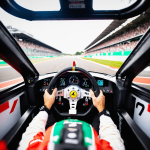
Flow, Aesthetic Arrest, and the Struggle for Alignment
March 5, 2025
The Mind, the Machine, and the Mystery: Can AI Ever Understand Consciousness?
March 11, 2025Introduction: The Fine Line Between Peak Performance and Burnout
In the world of high-performance engines, the redline marks the upper limit of an engine’s revolutions per minute (RPM). Push an engine beyond that threshold for too long, and it risks overheating, wearing down components, or even catastrophic failure. Yet, the redline is also where maximum power is generated. The best drivers know how to flirt with the redline without destroying the engine.
Life operates on the same principle. Whether in work, creativity, or personal growth, we all have a performance threshold—a place where we operate at peak capacity. But if we stay there too long without proper recovery, we risk burnout, mental fatigue, and diminishing returns.
The key to sustained high performance is not avoiding the redline but learning how to manage it strategically.
Lesson 1: Understand Your Redline—Know Your Limits
📌 In Racing:
- Each engine has a redline RPM—the point where it produces maximum output without damage.
- Skilled drivers learn their car’s limits and avoid unnecessary stress on the engine.
📌 In Life:
- Everyone has a personal redline—their maximum physical, mental, and emotional output before exhaustion sets in.
- Pushing hard is fine—but ignoring limits leads to breakdowns, whether in health, relationships, or productivity.
- Practical Application: Keep a performance log—track how long you can push yourself before exhaustion sets in. Recognize patterns of fatigue and adjust accordingly.
🚀 Lesson: Knowing when to ease off prevents long-term setbacks.
Lesson 2: The Role of Recovery—Cooling Down Matters
📌 In Racing:
- Cars have cooling systems—radiators, oil coolers, and airflow—all designed to prevent overheating.
- After intense laps, drivers often take a cool-down lap to let the engine recover before pushing again.
📌 In Life:
- If you never allow time for recovery, stress and exhaustion build until burnout occurs.
- High performance requires planned recovery periods—just like an engine needs a break, your brain and body do too.
- Practical Application: Implement strategic recovery—for every period of intense effort, schedule a deliberate cool-down phase (e.g., active rest, meditation, creative downtime).
🚀 Lesson: Recovery is not a weakness—it is a performance tool.
Lesson 3: Throttle Control—Sustained Performance Over Time
📌 In Racing:
- The fastest drivers don’t slam on the gas constantly—they modulate throttle input, applying power where it is most effective.
- Maintaining momentum is more efficient than constant acceleration and braking.
📌 In Life:
- Consistency beats intensity—sprinting in bursts without pacing yourself leads to burnout.
- Success isn’t about working at max effort all the time but knowing when to push and when to ease off.
- Practical Application: Apply the 90% Rule—instead of always operating at 100%, stay at 90% most of the time. You’ll maintain energy while staying highly productive.
🚀 Lesson: Sustainable success comes from controlled effort, not reckless exertion.
Lesson 4: Warning Lights—Recognizing the Signs of Overload
📌 In Racing:
- Dashboard warning lights indicate high engine temperature, oil pressure drops, or system failures.
- Ignoring them results in mechanical failure and race-ending damage.
📌 In Life:
- Our bodies and minds also send warning signals—fatigue, irritability, lack of focus, poor sleep, and diminished performance.
- Many people ignore these signs, thinking they can just push through—until a breakdown forces them to stop.
- Practical Application: Identify your personal warning lights—what are the early signs that you’re nearing burnout? Set a system to respond before it’s too late.
🚀 Lesson: Listening to your warning signs prevents damage that takes longer to repair.
Lesson 5: The Redline Zone—Tapping into Peak Performance Without Burnout
📌 In Racing:
- Drivers know when to push the car to the redline—usually in short bursts when acceleration matters most.
- Redlining strategically is what separates good drivers from great ones.
📌 In Life:
- There are moments where you need to push beyond your comfort zone—big projects, competitions, creative breakthroughs.
- The key is using the redline strategically—for critical moments, not as a constant state.
- Practical Application: Plan your “redline moments” in advance—schedule sprints of intense effort but follow them with deliberate recovery phases.
🚀 Lesson: Redline strategically, not constantly.
Conclusion: Mastering the Art of Sustainable High Performance
Like a finely tuned race car, our ability to operate at peak performance depends on understanding our limits, managing stress, and knowing when to push and when to recover. The key to long-term success isn’t just speed—it’s sustainable acceleration.
🔥 Push yourself, but respect your limits. 🔥 Recover as hard as you work. 🔥 Operate with precision, not recklessness.
🚀 The goal isn’t just to go fast—it’s to go far.